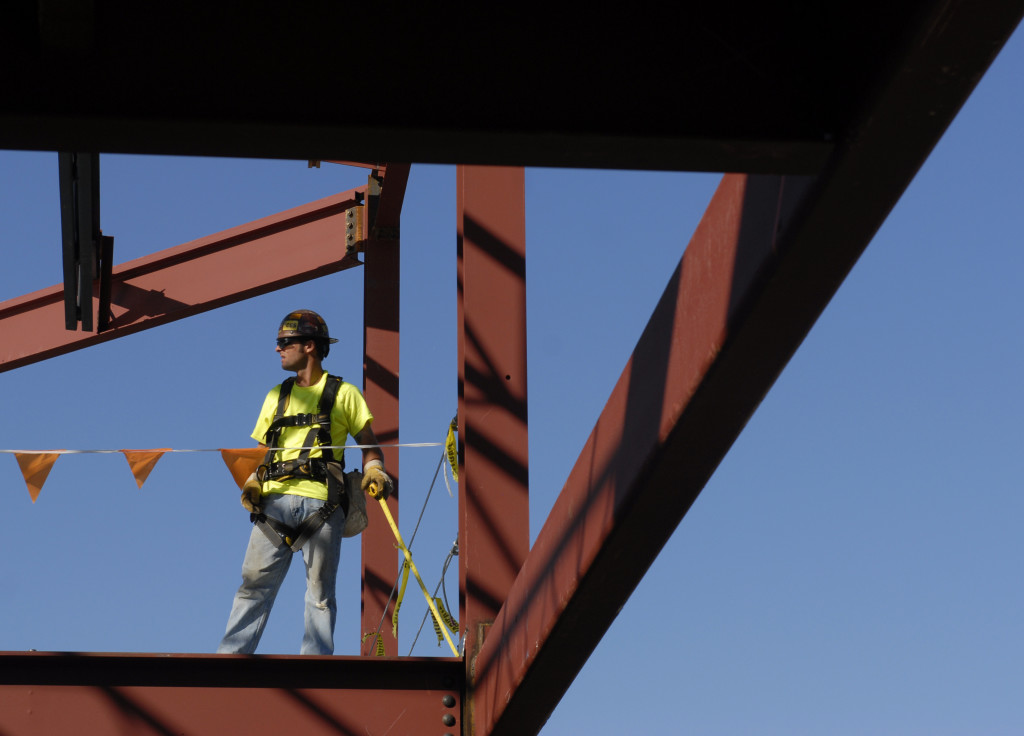Critical “tipping point” between unions and so-called “right to work”
BY CLARE HOWARD
As the nation celebrates Labor Day with parades and picnics, an “apocalyptic” moment is brewing in the United States with Illinois widely viewed as a critical pivotal state.
The question: support unions and a strong middle class economy or undercut unions with locally-negotiated, nonunion agreements that exacerbate wage inequality.
There are now 25 states in the country with legislation establishing so-called “right to work” laws that end collective bargaining by unions and 25 states retaining the rights of unions to bargain collectively.
Because collective bargaining for wages, benefits and working conditions is the major role of unions, an end to collective bargaining is considered a move to destroy unions.
Illinois Gov. Bruce Rauner is fighting hard to convert Illinois from a state with collective bargaining to a right-to-work state. Illinois is the last state in the Great Lakes region that has fended off pressure to end collective bargaining.
Robert Bruno, professor of labor and employment relations at University of Illinois, Urbana-Champaign, said recently in Peoria during a three-hour seminar at Local 649 International Union of Operating Engineers that this is an “apocalyptic” moment and “tipping point” in the battle to retain unions and the strong middle class that unions have created in this country.
He said the right-to-work movement has its origins in racism and segregation. For the most part, states with right-to-work laws are also states with restrictive voter ID laws and anti-gay rights legislation, he said.
“The reason why unionization did not spread in the south has everything to do with racism,” Bruno said.
Union organizers in the south were lynched because they were considered communists and racial integrationists, he said, adding, “Unionization is a real challenge to racism.”
He cited research that shows right to work reduces earnings and while it may initially reduce unemployment by 1 percent, research has shown that gain disappears within seven years. There is no evidence right to work results in job growth.
“There is faster job growth in Illinois than in neighboring right-to-work states,” he said. “Even if right to work (initially) reduces unemployment, the jobs pay less and (that means) less income taxes are paid.”
In his run for the Republican ticket for President, Scott Walker likes to tout his tough union position dismantling collective bargaining.
But there is no credible research that confirms passing right-to-work legislation will lead to higher job growth, said Kevin O’Brien, chairman of the economics department at Bradley University.
“Walker says he found the recipe, but where is the record? He goes after unions, cuts government and provides more funding for corporations, but high growth is more complicated than that,” O’Brien said. “Walker’s job growth record in Wisconsin is bad. Wisconsin has the worst job growth in the Midwest except for Iowa. It’s 35th in job growth.”
O’Brien said he and most economists favor increases in minimum wage to keep pace with inflation but a bigger benefit is the earned income tax credit that can be specifically targeted to low-income earners.
“Minimum wage is broad but earned income tax credit specifically rewards people who are working and earning low wages. I like it,” O’Brien said.
For example, increases in the minimum wage would affect teenagers from affluent families, but earned income tax credit specifically targets low wage earners.
People who say they hate welfare should favor the earned income tax credit because it rewards work, he said.
In terms of income inequality, O’Brien does not dispute that corporate CEO’s should make high wages, but he challenges the reason why American CEO’s make 300 times median worker salaries while Australian CEO’s make 70 times median worker salaries.
“We have incredible income inequality,” O’Brien said. “What value is the CEO adding? Are our CEO’s so much better than Australia’s?”
Income inequality has risen in America with the decline of unions, changing technologies and societal trends that started with Ronald Reagan’s cut in taxes on the highest income earners.
“People have become more tolerant of income inequality,” O’Brien said.
Income inequality is corrosive, Paul Krugman, a Pulitzer-prize winning economist has written in The New York Times.
Krugman cites another presidential candidate, Jeb Bush, who likes to tout Florida’s economy under his term as governor, however, Bush rode the housing bubble and he left office just before the bubble burst.
Republicans are campaigning for President and getting massive media coverage by stating and restating their economic expertise without research to support their claims, Krugman concludes and speculates their real reason is to undermine legitimate government programs that benefit people and the economy.
O’Brien, the Bradley professor, says at least part of their traction is due to poor public understanding of economics.
Part of the solution is for reporting to focused more on sound economics and less on the Kardashians and Bruce Jenner, he said.
Bruno wants greater public clarity on “bedrock values” of the American economy: middle class jobs, home ownership, equality, opportunity . . . all undermined by so-called right-to- work legislation.
Attending the Bruno seminar was Andrew Rand, chairman of the Peoria County Board and CEO of Advanced Medical Transport.
“I’ve been studying the right-to-work issue for the past six months,” Rand said. “I need to credibly argue with other CEO’s that this is bad for business. It’s important for business leaders and government to understand that.”

PHOTO BY CLARE HOWARD
Joseph Reising, member of Iron Workers Local 112, stands on an upper floor of the $10 million RLI Corp. expansion. In planning its project, RLI Corp. knew it wanted skilled trades for a high quality job. General contractor is P.J. Hoerr. RLI corporate headquarters will ultimately be a campus-like setting with several buildings connected with walkways.

10 comments for “Labor Day 2015”
Recent Comments